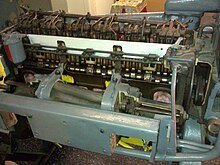Gray Marine 6-71 Diesel Engine

The 6-71 Gray Marine Diesel Engine is a marinized version of the General Motors Detroit Diesel 6-71 engine produced by the Gray Marine Motor Company. It was used in landing craft during World War II and is used today in private boats and training facilities.
Engine characteristics
The 6-71 is an inline six cylinder diesel engine.[1] The 71 refers to the displacement in cubic inches of each cylinder.[1] The firing order of the engine is 1-5-3-6-2-4.[1] The engine's compression ratio is 18.7:1 with a 4.250 inch bore and a 5.00 inch stroke.[1] The engine weighs 2,185 lb (991 kg) and is 54 inches long, 29 inches wide and 41 inches tall.[1] At 2,100 revolutions per minute the engine is capable of producing 230 horse power (172 kilowatts).[1] V-type versions of the 71 series were developed in 1957.
The 6-71 is a two-stroke cycle engine.[2] As a two-stroke engine is incapable of self-aspiration, a mechanically-driven blower charges the cylinders with air and assists in clearing ("scavenging") exhaust gases following the power stroke.[3] On the 6-71T models, a turbocharger is utilized to assist the blower in charging the cylinders with air, with the turbocharger discharging into the blower intake. Unlike the turbocharger of a four-stroke engine, the primary purpose of the 6-71T's turbo is to reduce the blower's parasitic loading at higher engine power levels, which improves fuel economy.[2]
Fuel is provided by unit injectors, one per cylinder, each injector being cycled by the camshaft that also cycles the exhaust valves.[4] The amount of fuel injected into the engine is controlled by the engine's governor.[1] The engine cooling is via liquid in a water jacket. In a boat, cool external water is pumped into the engine and passed through a heat exchanger mounted on or nearby in a "double loop" configuration.[4]

Development
The Gray Marine 6-71 Marine Diesel was developed from the General Motors 6-71 diesel engine that was in use for on-road applications, farm machinery, and other off-road applications. Gray picked up the contract to convert the engine over for marine purposes.[5]
Use
The 6-71 was used for Higgins LCVP, a landing craft used in larger numbers during World War II.[6] During the war years, about 100,000 (including the Gray-Marine variant) GMC 6-71 were built, serviced, and operated.[3]
References
- ^ a b c d e f g Barrington Diesel club. "Detroit Diesel 6-71 engine specs at Barrington Diesel Club". Archived from the original on 8 March 2012. Retrieved 11 April 2012.
- ^ a b Tugboat Enthusiasts Society of the Americas. "DETROIT DIESEL INLINE 71 SERIES". Retrieved 11 April 2012.
- ^ a b Caprio, Dennis. ""Jimmy" Rules: Detroit Diesel 6-71". Yachting Magazine. Retrieved 18 April 2012.
- ^ a b G.M. Grey Marine Model 64 HN9. Seattle, Washington: Hatch and Kirk INC.
- ^ Homfield, Max. "A Brief History of Gray Marine Engines". Gas Engine Magazine. Retrieved 18 April 2012.
- ^ Grayson, Stan (1999). Engines Afloat. Devereux Books. ISBN 0-9640070-7-X.
